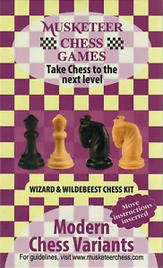Piececlopedia: Gnu / Wildebeest
Historical notes

The Gnu is a piece that combines the movement possibilities of the Knight and Camel, and named after an African ungulate. It has been used in fairy chess problems - in 1939, a mate in two problem with a Gnu by W. Karsch was published in Fairy Chess Review, but I do not know if this is the first appearance of the piece. In A Guide to Fairy Chess (1962), Anthony Dickins gives Gnu as the name of a piece that moves as a Camel or a Knight. The Gnu also occurs in several large variants on these pages including Ganymede Chess and Io Chess by Mark Hedden; and Bachelor Kamil, Ecumenical Chess, and Wildeurasian Qi by Charles Gilman. It appears under the name Wildebeest, another name for the same animal, in Wildebeest Chess by Wayne Schmittberger and Promo Chess by Glenn Overby.
Movement
The Gnu (or Wildebeest) is a compound piece that moves as a Knight or a Camel. So, it is both a 1-2 leaper and a 1-3 leaper. As a leaper, it can move directly to a space without being blocked by intervening pieces. The diagram below shows the spaces it can leap directly to.
It is a triangulating compound. That is to say, its longer move is equivalent to two of its shorter ones at right angles, so that it can return to a cell in three moves, in this case a Camel move and two Knight moves. In contrast neither the Knight nor the Camel can return to a square in an odd number of moves.
Checkmating
The Gnu (or Wildebeest) is both strong and has a move pattern that allows checkmate positions with just assistence of its King, but by a tactical coincidence it cannot deliver the final blow to force these position, and is thus a minor piece. It needs only miniscule help to checkmate a bare King, though. Try it!
Purchase
The Musketeer Chess line of Chess variant pieces includes kits with Wildebeest pieces in them.


Printable Pieces
The following designs are available for printing on a 3D printer. Links are to Thingiverse.


Notes
This piece generally cannot force checkmate against a bare king.
This is an item in the Piececlopedia: an overview of different (fairy) chess pieces.
Reference: G. Jellis, Notes on Generalized Chess, Variant Chess vol. 1, issue 1, p. 8-9, 1990.
Written by Hans Bodlaender.
Graphics and some additional text by Fergus Duniho.
Checkmating section by H. G. Muller
WWW page created: May 30, 1999.
Last updated: December 22, 2024.
